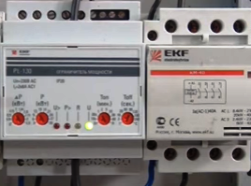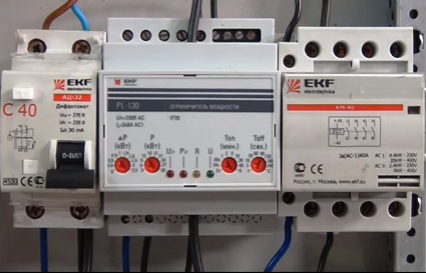Categories: Featured Articles » Electrician at home
Number of views: 12085
Comments on the article: 1
Power limiter - brief description, application in home wiring
 A power limiter is a device designed to limit the amount of power consumed. This device monitors the load and if it grows above the established level, it deenergizes the consumer. The operation of the power limiter is carried out with a time delay of several seconds to several minutes. That is, if the consumer includes electrical appliances in the network whose total power exceeds the set limit, then the relay will trip after the set time.
A power limiter is a device designed to limit the amount of power consumed. This device monitors the load and if it grows above the established level, it deenergizes the consumer. The operation of the power limiter is carried out with a time delay of several seconds to several minutes. That is, if the consumer includes electrical appliances in the network whose total power exceeds the set limit, then the relay will trip after the set time.
There is an LED on the power limiter that signals overload. Depending on the type of limiter, the limiter itself may have a digital indicator that shows the current power value, and if the set power limit (overload) is exceeded, a countdown occurs, after which the power supply will be de-energized.
The power limiter is triggered when the load current is exceeded, therefore this device, in addition to the main function of limiting the power consumption, protects the electrical wiring of the apartment from damage.
In fact, the principle of operation of the power limiter is similar to the principle of operation thermal release circuit breaker, which protects the wiring from overload. Why then do not limit yourself to using a circuit breaker at the wiring entry? Let's consider some characteristic features of the power limiter.

OM-110 power limiter
Firstly, the power limiter measures the power (load current flowing through it) with a low error of 2.5% on average. Secondly, it is possible to change the value of the limited power over a wide range, without the need to install another device. In addition, you can set the time delay during which the power limiter must operate.
The circuit breaker trips only at a certain value of the load current. In this case, the response time of the thermal release of this protective device depends on the magnitude of the load current. It should also be noted that the response time of the thermal release depends on the ambient temperature where the circuit breaker is installed. For example, in winter, this protective device will withstand a slightly higher current for a longer amount of time than in summer.
In addition, the power limiter has the function of automatically switching on after an overload trip. That is, if the wiring is disconnected due to exceeding the set power limit, then after a specified time the power limiter will power up the wiring itself, without the need for intervention.
This function allows you to use this device to limit power in a sealed metering and distribution panel, to which the consumer does not have access. For example, when using only a circuit breaker to limit power, after each operation it is necessary to go to the shield and turn it on. If a power limiter is used, the process of power outage and renewal of power supply occurs automatically.

Power limiter PL-130
The use of power limiters in home wiring is also due to the fact that the installed wiring, its load capacity, and accordingly the protective devices of this wiring can be rated for a rated current that significantly exceeds the load limits set by the power supply company.
In this case, the use of a power limiter allows you to adjust the power limit in a wide range, without the need to replace protective devices. At the same time, there is always the opportunity to increase or decrease the load limit.
For example, the electrical wiring of a house can supply a load of a total value of 20 kW.At the moment, in accordance with the technical conditions for connecting the house to the electric network, the permissible power limit is 7 kW, which is set on the power limiter. If after some time there is a need to increase the power limit, then if you receive the appropriate permission for this, it will be enough just to change the settings of the power limiter.
The power limiter protects the wiring from overload, but it does not protect the wiring from short circuits. Therefore, the circuit breaker at the wiring entry must be installed in any case, since it will protect the wiring, including the power limiter in case of a short circuit in the wiring or from overload in case of failure of the power limiter.
As for the very need to install a power limiter in home wiring, then, by and large, it is needed not by the consumer, but by the energy supply organization. For the consumer, the main thing is to provide uninterrupted power to the home wiring, to provide the ability to include all electrical appliances in the network. And the power limiter very often does not allow the use of all electrical appliances in the house without restrictions due to the small allocated power.
In this case, power outages occur almost immediately. While limiting the power by installing a circuit breaker of the appropriate rating, the shutdown does not occur immediately, that is, with a slight increase in the load current above the rated value, the circuit breaker can operate for about an hour (depending on the magnitude of the load). As a rule, during this time, the load decreases and the thermal release of the circuit breaker does not have time to trip.
It is more convenient for power supplying organizations to use power limiters, since by setting an allowable power limit for each consumer, it is possible to prevent possible overloading of power transformers in power substations by ensuring that consumers are automatically disconnected from the network if the allowable power limits are exceeded.
The need to install a power limiter significantly increases the cost distribution panel, since in addition to the power limiter itself, it is necessary to install a contactor (magnetic starter) in the switchboard. This is due to the fact that the power limiter itself is not intended for switching high currents. In this case, the switching of the load currents is carried out by the contactor, and it is controlled by supplying voltage to its coil from the output contacts of the power limiter.
For the consumer, perhaps the only advantage of using a power limiter, in addition to protecting the wiring, is the ability to timely detect an unauthorized connection to the home wiring. That is, if the power limiter disconnects the wiring, but at the same time high power was not included in the network, this indicates that someone has illegally connected to your wiring.
The need for a power limiter is established by the supplying organization. Therefore, often the consumer does not have freedom of choice - it is mandatory to install a power limiter and, accordingly, a modular contactor (magnetic starter). In the event that there is still a choice, it is better to limit yourself to just setting the circuit breaker to the nominal value corresponding to the load limit.
As mentioned above, this option allows you to use all electrical appliances without restrictions, since the circuit breaker does not work immediately and allows you to not disconnect the home wiring during peak loads.For example, while the electric kettle, washing machine, etc.
See also at bgv.electricianexp.com
:
